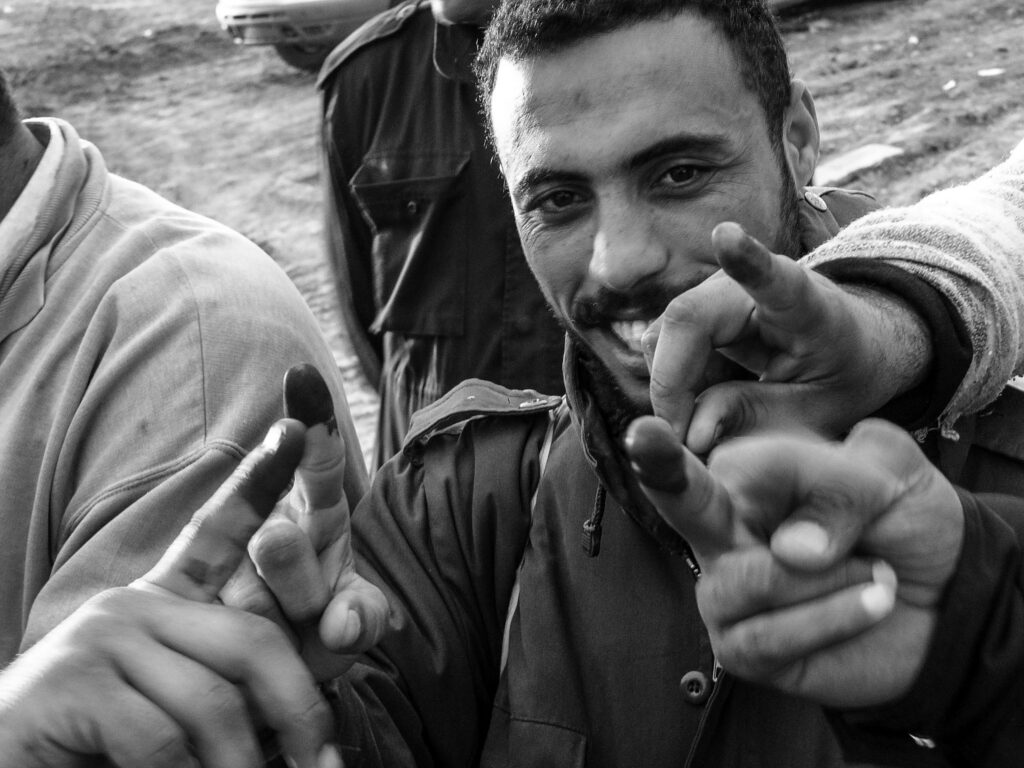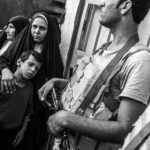Photographer Bill Putnam was searching palm groves along the arching river of the Tigris south of Baghdad in 2004 when the Iraqi soldiers with the U.S. Army unit he was embedded with started to drop. The sun was harsh and the air was thick with humidity that July day, 20 years ago. Patrolling under the weight of 70 pounds of kit, body armor and weaponry created the perfect environment for heat exhaustion. Putnam pointed his camera.
The black and white photo he made is a swirl of blurred motion. The Iraqi soldier is pulled onto a stretcher by firm hands surrounding him. It wasn’t until Putnam returned to the U.S. military base later that day that he learned it was over 140 degrees Fahrenheit.
The image is part of “The Burn Pit: Iraq, 2004-2006,” a documentary project consisting of roughly 250 digital and 150 film photos that Putnam made as an Army photographer and later as a freelance photojournalist in Iraq, one of a generation of journalists for whom Iraq and Afghanistan remains a defining moment even two decades later.




It was even more so perhaps for Putnam, a U.S. Army veteran who returned to Iraq and then later went to Afghanistan as a civilian documenting war.
Now, 49, Putnam works in public affairs in the Chicago field office of the U.S. Department of Veterans Affairs. He wanted to make clear the project is not tied to his current job with the VA.
The images that are part of his collection, which will launch on Instagram on March 10, consist of the everyday environments and humanity within a country at war . Over the span of the next two years, Putnam intends to share his project, one photo at a time, on the 20th anniversary that each shot was captured.
The Burn Pit is not only a project of personal healing but also a reminder of the legacy of the Iraq war and those who witnessed it.
“It’s on the forefront of my mind. It’s still there,” Putnam said. “I just want people to see these images and realize that we were there, and we still are.”
Putnam began his military career as an active duty soldier in the Army in 1995, transitioning into the role of a public affairs specialist in 1999. He was deployed to Kosovo in 1999 and 2001. Columnist and former Lieutenant Colonel Peter Molin, who served as an executive officer of an infantry battalion Putnam worked with during his second deployment to Kosovo, appreciated the emotion and intimacy within his photography.
“I think his heart is in the right place. He’s passionate about soldiers and helping soldiers,” Molin said. “He’s gotten a fair amount of acclaim for his pictures, but I think he deserves even more.”
In 2003, Putnam worked as a specialist at the Pentagon, where he observed the initial invasion of Iraq. It wasn’t long after that Putnam was deployed to join his unit.
“It was a weird dynamic to be in because there was conflict, like gun fights and IEDs,” Putnam said, referring to improvised explosive devices or homemade bombs. “But on the same day you could go out and play soccer and hand seeds out to farmers.”
The project is not meant to be political, Putnam said. But there is ongoing legislation and lawsuits surrounding the burn pits, the open-air garbage piles where waste was burned with jet fuel around military bases in Iraq and Afghanistan. In 2021, the VA formally recognized several respiratory conditions and rare cancers linked to the largely incinerators with the PACT Act.
Putnam himself was affected by the burn pits when he was stationed at Forward Operating Base Falcon, a downwind base in southwest Baghdad.
Journalist and former NPR correspondent Sean Carberry said that the title of the project will hit home for a lot of veterans.
Carberry met Putnam at a memorial service for mutual friend NPR photojournalist David Gilkey in 2016. He described Putnam’s work as powerful and immediately recognizable.
“The expressions, actions, emotions and circumstances are all vividly conveyed,” Carberry said. “You can see when someone cares about the people that they’re covering. There’s a strong humanity to his work.”
Photography as a medium is in a state of constant reinvention, as technology paves the way for transformative iterations to take place in a way that wasn’t possible 20 years ago. Putnam was one of the first war photographers to embrace an iPhone in the field, to use the device in a purposeful way to make images and art.
Gregory Foster-Rice, an associate professor who teaches photo history at Columbia College Chicago, described Instagram as a forum of publication as ephemeral. While artists may find social media as a very accessible space for their work, it’s also very disposable in the way that the algorithm is designed.
“Using Instagram is that idea of going straight into the new current channel of transmission, which is the internet.” Foster-Rice said. “They’re leaning into the present moment of how people experience photography.”
As his deployment to Iraq was ending he ran into Time magazine bureau chief Michael Ware, who wrote a credential letter to help him return overseas.
“I went back six months after I came home. My friend had just had his first kid, a week after I got there. I didn’t meet them until they were nine months old.”
Putnam did the math. From 1999 to 2013, 1/3 of that time was spent in numerous combat zones, starting at the age of 24. Armed with an M-16, a DSLR and film camera, Putnam captured the world of joys and hardships around him. He did not take into account that his time overseas as an observer and soldier would be a double edged sword.
Carberry recognized the conflicting responsibilities that Putnam faced as a combat photographer, describing his work as not only a great challenge but an even greater accomplishment to capture his environment with honesty.
“His job was essentially to pull a different trigger, to snap a camera instead of shooting a gun.” Carberry said. “It’s a much tougher spot to be in because you’re in uniform.”
Within the intensity of these environments of conflict, where does the healing begin?
Carberry said there is no question that The Burn Pit was a part of Putnam’s healing process, which veterans of Iraq and Afghanistan, like those from Vietnam and even older conflicts, know is a life-long process. War is not something people get over.
For some people within the world of combat journalism, the healing never happens at all, in part, because of their commitment to keeping the stories alive but also because sitting still means processing the events that they had witnessed. Consumers of Putnam’s images will have various reactions based on their relationship to the moment. For Putnam, the moment is deeply embedded. It is personal.
He said the healing journey starts with bits and pieces. “It’s always on my mind in some way. A part of healing is acknowledging it, but also trying to not let it envelop me entirely,” Putnam said. “I was lucky that I managed to get through it all alive. There are people I know who are dead, or broken mentally. Somehow I landed on my feet. Stupid luck on my part.”
Alina Pawl-Castanon is a Chicago-based photojournalist.

